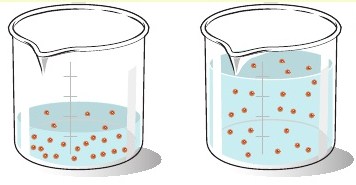Concentration & Dilutions

Terms
Concentration: A liquid substance that is made up of a % or ratio such as a solution bottle has a concentration of 12%. 12% means 12 grams in 100 ml.
Dilution: Diluting or filling liquid substance into another liquid substance such as "I am going to dilute 12 ml of medication into this 240 ml of water".
Important
There are several ways or formulas to solve concentration and dilutions math problems. The purpose of these formulas is find the total percentage or ratio strength from these solutions being mixed also formula can find ml's from a specific stock solution. Let's start with a basic example solved by a well known formula.

Formula: C1 x V1 / C2 or V2
Symbol explaination: C1 refers to first concentration (%) given, V1 refers to first volume (ml) given, C2 refers to second concentration (%) given, V2 refers to second volume (ml) given.
EX 1. If 500 ml of a 15% v/v solution of methyl salicylate in alcohol is diluted to 1500 ml, what is the percentage strength v/v?
Step 1- Set up formula > C1 x V1 / C2 or V2
Step 2 - Plug numbers into formula > 15% x 500 ml / 1500 ml
Step 3 - Calcualte for answer > 15% x 500 ml = 7500 / 1500 ml = 5% v/v
 Try solving this question with the Inverse Proportion method also used for calculating concentration and dilutions by clicking HERE
Try solving this question with the Inverse Proportion method also used for calculating concentration and dilutions by clicking HERE
Now let's advance the level of question with some ratios
EX 2. How much (in ml) of a 1:400 w/v stock solution should be used to make 4L of a 1:2000 w/v solution?
Step 1 - First off always convert ratios into a % before pluging numbers into the formula
1:400 > 1/400 = 0.0025 x 100 = 0.25% This will be the second concentration because it stands alone (C2)
1:2000 > 1/2000 = 0.0005 x 100 = 0.05% This will be the first concentration because it comes with it's pair (C1)
Step 2 - 1 liter = 1000 ml, so 4 liters = 4000 ml
Step 3 - Set up formula > C1 x V1 / C2 or V2
Step 4 - Plug numbers into formula > 0.05% x 4000 ml / 0.25% = 800 ml
 Let's get this going with a ratio/fraction twist
Let's get this going with a ratio/fraction twist
EX 3. If 250 ml of a 1:800 v/v solution is diluted to 1000 ml, what will be the ratio strength v/v?
Step 1 - Covert ratio into a %
1:800 > 1/800 = 0.00125 x 100 = 0.125% This is the first concentration because it comes with it's pair (C1)
Step 2 - Set up formula > C1 x V1 / C2 or V2
Step 3 - Plug numbers into formula > 0.125% x 250 ml / 1000 ml = 0.03125%
Step 4 - Notice question is asking for ratio strength, so let's convert 0.03125% into a fraction first also
a reminder anything that is a % is over 100.
0.03125 numerator
100 denominator ---> Voila here is our fraction
Step 5 - Reduce our numerator to a whole number from our fraction, and multiply denominator to 100. Create new fraction.
* 0.03125 x 100 = 3.125 You can also move decimal point 2 places to the right
* 100 x 100 = 10000
3.125
10000 ---> Voila our new fraction
Step 6 - Calculate fraction by dividing 3.125 to the numerator and denominator to get our ratio.
3.125 / 3.125 = 1
10000 / 3.125 = 3200 Our ratio--< 1:3200 >--Our ratio